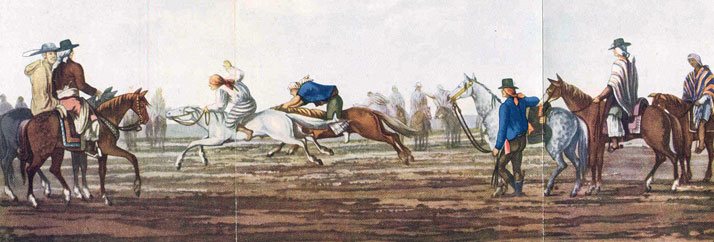|

A horse race
(Emeric Essex Vidal, 1820) |
In cuadreras, no consideration was given to the
horses’ weight or age or to the riders’ weight or height.
They ‘ride without saddle, whip, or spur, having only a
bridle without a bit; and thus the spirit and speed of the
animals have fair play’ (Essex Vidal 1820: 113).
Frequently, the cancha (course) was a common plain
or road, and only three or four races were performed in an
entire afternoon, ‘which tire the patience of any person
accustomed to English racing’ (113).
Inextricably associated with gambling in Britain
and in Argentina, ‘great sums of money [were] often staked
on these matches’ (113). Essex Vidal adds that spectators
were numerous, including friars who were ‘remarked as
great betters’. These and other persons from all walks of
life were constant spectators at cuadreras. However
women were not allowed to attend this exclusively male
entertainment. In Buenos Aires, there were frequent races
at the Beach Road (the present-day motorway to La Plata), Calle Larga (Montes
de Oca Avenue), and the low grounds of Recoleta and Retiro.
Horse
Racing a la inglesa
In 1826, the Buenos Ayres Race Club was founded by a group of
British and Irish merchants of that city. On 6
November 1826, the first races a la inglesa
(English-style, that is, on a circular course), were held
in Barracas. The winner was Thomas Whitfield’s Shamrock,
who won by many lengths, followed by Baron and
Teazle in the first race, and St George and
Integrity in the second one. Later, in 1835, races
were organised with fifteen or more horses and betting was
considerable: ‘the first [race] will be for 100 dollar
Stakes, and the second for 50’ (The British Packet, 3 January 1835
cited in: Hanon, 2005: 52). Another novelty of the
English-style races was that women were present among the
audience, some of them in carriages and others on
horseback. Races were also very popular in Recoleta.
By the
mid-1840s, there were races a la inglesa organised
in Barracas, Recoleta and Belgrano. On 31 October 1844, a
‘picnic party’ on James White’s property in Belgrano
attracted prominent spectators as well as ‘respectable
criollo and foreign families’ (The British Packet,
31 October 1844 cited in: Hanon, 2005: 53). The afternoon
races included for the first time several gentlemen
sporting the jockey attire. In 1849 White opened a new
course ‘stretching along the base of a semi-circular
inclined plane’ (53). It was twenty-six metres wide and
covered fifteen cuadras, with a straight of 150
metres before the starting line. The following year, the
Foreign Amateurs Racing Society was established, and its
members organised races in springtime and autumn. They met
in the rooms of the Strangers Club of Buenos Aires, and
supported the importation of thoroughbred horses.
In 1853, local mares began to be bred with imported
stallions, like the bay Azael, and James White’s
Belgrano. Their contemporary Tam O’Shanter was
the great favourite in all races. The Racing Society,
dominated by the British and Irish merchants of Buenos
Aires, organised races until 1855, when local meetings in
Capilla del Señor, Carmen de Areco, Pergamino and other
towns of Buenos Aires province attracted the attention of
the English-speaking and local public resident in the
camp.
Irish on
Horseback
Having been tenant farmers in Ireland,
the Irish dreamt of becoming landlords in the Río de la
Plata. Their use of horses as farming devices at home
developed into a major interest in races and breeding as
external symbols of landownership in the Pampas.
Early nineteenth-century races in Ireland
were predominantly organised and attended by landlords or
their associates, and followed the patterns of English
racing. In County Westmeath,
the famous Kilbeggan races were held for the first time in
1840. A group of landlords, professionals and
administrators launched a Challenge Cup valued at forty
guineas, with ten pounds added by the stewards. Racing was
held in several locations around Kilbeggan, including the
present site at Loughnagore (Kilbeggan Races).
When the Irish went to Argentina
and Uruguay, they largely settled in rural areas and were
partially responsible for the cultural transfer that
converted the local cuadreras into English-style
races. Most of them learnt or perfected their basic riding
skills brought from Ireland upon their arrival to Buenos
Aires. In a few years they would be able riders and expert
horse breeders.
In 1847, the Revista del Plata reported a discovery by
an Irish settler in Monte of a new method of castrating
horses. ‘The method in question was rather an introduction
than a discovery, for according to the description of the
performance of the operation it was nothing more or less
than the form of castration in common practice in Ireland
in such cases’ (Murray 1919: 214). Other stories were told
of the ability of certain Irish immigrants to ‘set’ the
bones of both horses and humans.
A story in Monte illustrates the accentuated learning curve
in horse-riding experienced by some of the new Irish
immigrants:
A native
attacked an old Englishman, named Davy, trying to ride him
down. Davy struck the native’s horse with his stick, the
rider jumped off and stabbed the old man several times. A
young Irishman named John Gilligan, attracted by the
shouts of the old man, rode up to the scene and dashed
between the native and his victim; the native at once
turned on him; Gilligan rode his horse against him,
knocking him down and then jumped off to assist the old
man who was dying; while thus engaged, and entirely
unarmed, the native got to his feet, ran at Gilligan and
stabbed him in the stomack
[sic],
causing almost immediate death (Murray 1919: 215).
|

